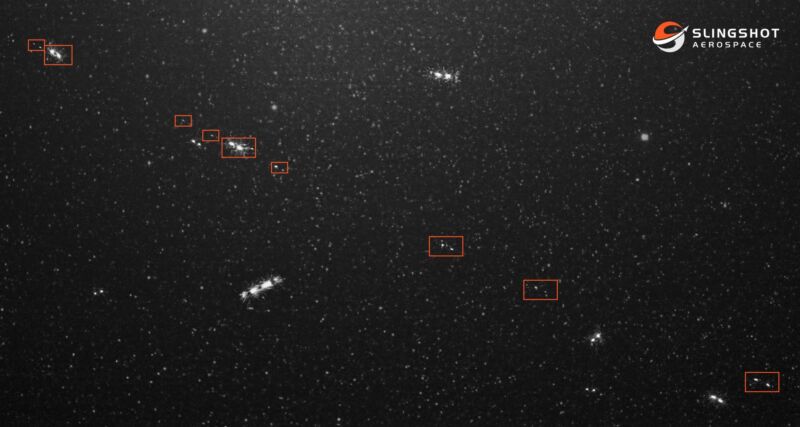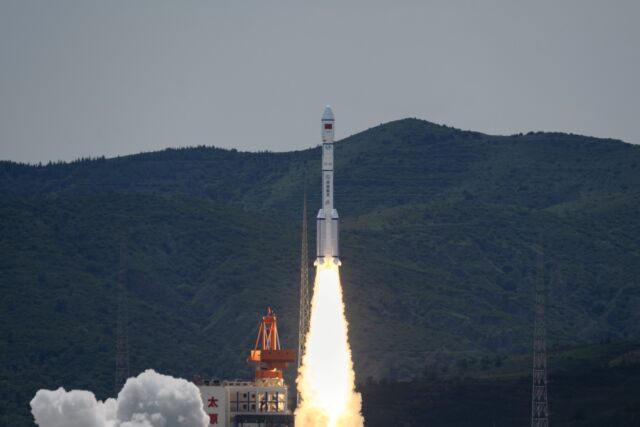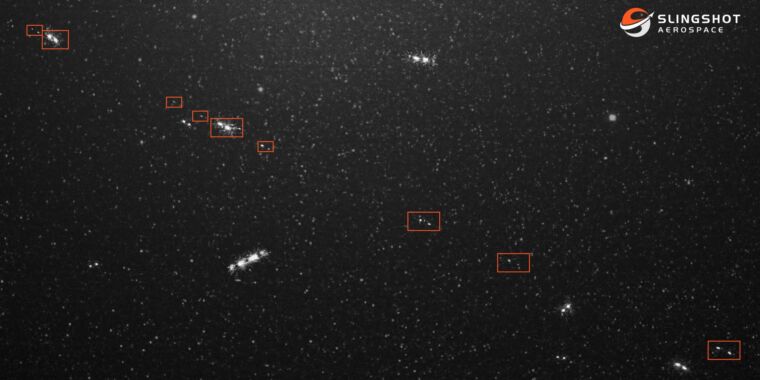China’s Long March 6A rocket is making a mess in low-Earth orbit
Another one —
After nearly every flight, the upper stage of this rocket breaks apart in orbit.

Enlarge / Debris from the upper stage of China’s Long March 6A rocket captured from the ground by Slingshot Aerospace.
The upper stage from a Chinese rocket that launched a batch of Internet satellites Tuesday has broken apart in space, creating a debris field of at least 700 objects in one of the most heavily-trafficked zones in low-Earth orbit.
US Space Command, which tracks objects in orbit with a network of radars and optical sensors, confirmed the rocket breakup Thursday. Space Command initially said the event created more than 300 pieces of trackable debris. The military’s ground-based radars are capable of tracking objects larger than 10 centimeters (4 inches).
Later Thursday, LeoLabs, a commercial space situational awareness company, said its radars detected at least 700 objects attributed to the Chinese rocket. The number of debris fragments could rise to more than 900, LeoLabs said.
The culprit is the second stage of China’s Long March 6A rocket, which lifted off Tuesday with the first batch of 18 satellites for a planned Chinese megaconstellation that could eventually number thousands of spacecraft. The Long March 6A’s second stage apparently disintegrated after placing its payload of 18 satellites into a polar orbit.
Space Command said in a statement it has “observed no immediate threats” and “continues to conduct routine conjunction assessments to support the safety and sustainability of the space domain.” According to LeoLabs, radar data indicated the rocket broke apart at an altitude of 503 miles (810 kilometers) at approximately 4: 10 pm EDT (20: 10 UTC) on Tuesday, around 13-and-a-half hours after it lifted off from northern China.
At this altitude, it will take decades or centuries for the wispy effect of aerodynamic drag to pull the debris back into the atmosphere. As the objects drift lower, their orbits will cross paths with SpaceX’s Starlink Internet satellites, the International Space Station and other crew spacecraft, and thousands more pieces of orbital debris, putting commercial and government satellites at risk of collision.
A new debris field of nearly 1,000 objects would be a significant addition to the approximately 46,000 objects Space Command tracks in Earth orbit. According to statistics compiled by Jonathan McDowell, an astrophysicist who monitors global launch and spaceflight activity, this would rank in the top five of all debris-generation events since the dawn of the Space Age.
This rocket has a track record
The medium-class Long March 6A rocket has launched seven times since debuting in March 2022, and military and commercial satellite tracking organizations have reported several breakups of the rocket’s upper stage. In November 2022, a Long March 6A upper stage disintegrated in orbit, creating a debris field of more than 500 trackable objects, according to NASA’s Orbital Debris Program Office.
Commercial satellite tracking companies observed smaller debris fields following several other Long March 6A flights this year.
In its space environment statistics report, the European Space Agency says there have been more than 640 “breakups, explosions, collisions, or anomalous events resulting in fragmentation” in orbit. So these things happen frequently. But it’s not clear what makes the Long March 6A, which has a relatively short flight history, particularly vulnerable to creating debris.

Enlarge / A Long March 6A rocket launches the first 18 Internet satellites for China’s Qianfan, or Thousand Sails, broadband network.
Most rockets operating today either reignite their engines to reenter the atmosphere after deploying their payloads, or if that’s not feasible, they “passivate” themselves to empty their propellant tanks and drain their batteries to reduce the risk of an explosion.
In a report last year, NASA’s Orbital Debris Program Office said the Long March 6A upper stage has a mass of about 5,800 kilograms (12,800 pounds) without kerosene and liquid oxygen propellants. It is powered by a single YF-115 engine.
The launch Tuesday began the deployment of China’s “Thousand Sails” Internet network, which will initially consist of 1,296 satellites, with the possibility to expand to more than 14,000 spacecraft. This will require numerous launches, some of which will presumably use the Long March 6A.
“If even a fraction of the launches needed to field this Chinese megaconstellation generate as much debris as this first launch, the result would be a notable addition to the space debris population in LEO (low-Earth orbit),” said Audrey Schaffer, vice president of strategy and policy at Slingshot Aerospace, a commercial satellite tracking and analytics firm.
China has been responsible for several space debris incidents beyond the latest problems with the Long March 6A rocket. In 2007, China destroyed one of its own spacecraft in an anti-satellite missile test. This was the worst-ever instance of creating space debris, resulting in more than 3,000 trackable objects, and an estimate 150,000 or more smaller fragments.
On four occasions from 2020 through 2022, the massive core stage of China’s heavy-lift Long March 5B rocket has reentered the atmosphere in an uncontrolled manner, raising concerns that falling debris could put people and property at risk on Earth.
China plans more flights with its Long March 5B and Long March 6A rockets. China continued flying the Long March 5B rocket despite the risk it posed to people on the ground. Debris fields in orbit, however, don’t directly threaten any people on Earth, but they do raise the risk to satellites of all nations, including China’s own spacecraft.
“Events like this highlight the importance of adherence to existing space debris mitigation guidelines to reduce the creation of new space debris and underscore the need for robust space domain awareness capabilities to rapidly detect, track, and catalog newly-launched space objects so they can be screened for potential conjunctions,” Schaffer said in a statement.
This story was updated with the detection of additional debris fragments by LeoLabs.
China’s Long March 6A rocket is making a mess in low-Earth orbit Read More »
